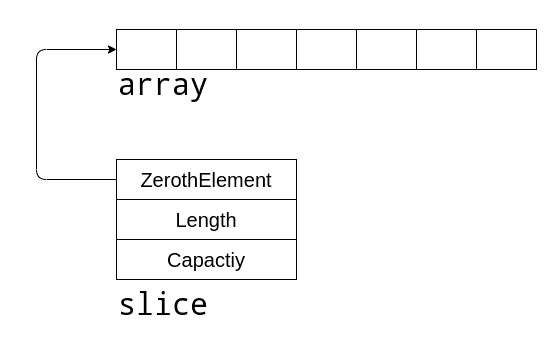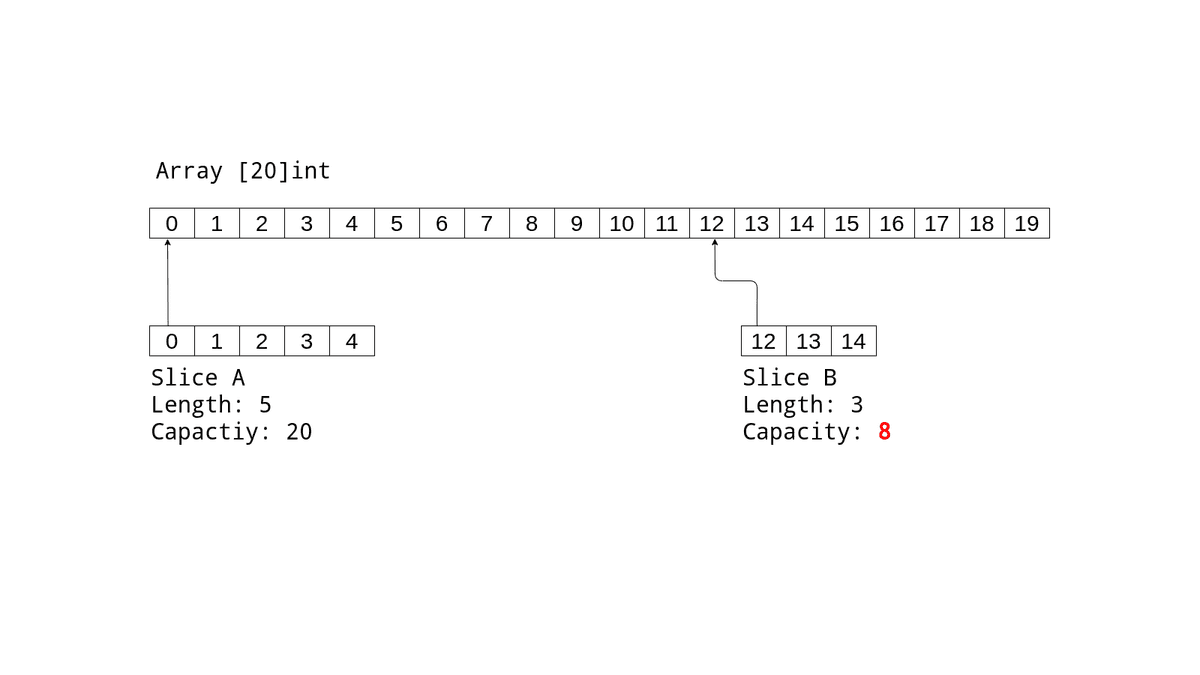Anatomy of Go Slices
I've started to use a lot of Go recently. I just love the language! Seriously, I don't think I have felt this much love for any other language!
I'm ashamed to admit that it was up until yesterday that I didn't quite understand the behavior and implementations of Slices in Go. There are already so many great blog posts out there that I don't think I have anything to add. However, that shouldn't stop me from writing another blog post on the subject because with that mindset my blog wouldn't even exist. So in addition to the hundred articles out there on Go Slices, here's the 101th. 😁
Slices
Slices are flexible and they should be preferred over arrays whenever possible. The most important thing to note is that slices have Arrays underneath them. I like to think of slices as the frontend for arrays.
Visualizing a slice as a struct as shown below can be helpful
type sliceHeader struct {
Length int
Capacity int
ZerothElement *byte
}ZerothElement in sliceHeader points to the first* element of the array underneath. It doesn't necessarily have to point to the *first* element itself as we will see later.
Slice Capacity
One thing that just seemed a little off to me in the beginning was the need for capacity in slices. How is it any different from the length of the slice itself ? None of the languages that I was familiar with had this concept of length and capacity. Almost always, the length was sufficient to define the size of an array or a list or whatever you want to call it.
The capacity of a slice can be set when creating the slice with the make function. If no capacity is supplied then it defaults to the length of the slice.
make([]Type, length, capacity)
make([]Type, length)To put it simply, the capacity of a slice is the size of its underlying array*. It's a little complicated than that. We'll cover it in a minute.
Let's start by making a new slice with a predefined capacity.
mySlice := make([]int, 2, 5)
// [0, 0]This code will internally create an array of integers of size 5. However, the slice will have access to only the first two elements of the array since its length is 2. If we try to access the third element then we get a runtime error.
mySlice[2]
// panic: runtime error: index out of range [2] with length 2Now consider that we need to add a third element to mySlice.
myNewSlice := append(mySlice, 10)
// [0, 0, 10]Take a moment to think and tell me this - did the append function create a new array?
It didn't !
What actually happened here is we created a new slice with an incremented length of 3 and the new element 10 was inserted into the array. But this new slice still points to the same array. We have a situation where both mySlice and myNewSlice are pointing to the same array. I think that's pretty cool.
Multiple slices can point to the same array
Now, of course, this was only possible because the array underneath actually had room for growth. If initially, we had set the capacity of mySlice to 2 then the append function would have no choice other than to create a new array. As an exercise, you can try appending more than 10 items to the slice and observer the behavior.
Let's verify this in code
mySlice := make([]int, 2, 5)
fmt.Println(mySlice)
fmt.Printf("mySlice's Address: %p\n", mySlice) // 0xc000100030
myNewSlice := append(mySlice, 10)
fmt.Println(myNewSlice)
fmt.Printf("myNewSlice's Address: %p\n", mySlice) // 0xc000100030You'll see that the first elements of the two slices still point to the same address.
A closer look at the Slice Capacity
Earlier when I said "The capacity of a slice is the size of its underlying array", I lied. It can be the case but it's not quite accurate. Let's take a look at the example below
We have that two slices sliceA and sliceB and both of them have a pointer to the same array but they represent different "pieces" of the array. sliceA represents the first 5 elements of the array while sliceB represents the 3 elements starting from the 12th index.
If you noticed, the capacity of sliceB is actually not 20 - it's 8 even though the underlying array has size 20. In order to measure the capacity of a slice, not only do we need to know the size of the underlying array we also need to know where in the array the slice begins. So a more accurate definition of capacity would be
The Capacity of a slice is equal to the length of the underlying array, minus the index in the array of the first element of the slice (zero in this case).
Let's verify this in code
package main
import "fmt"
func main() {
parentSlice := []int{0, 1, 2, 3, 4, 5, 6, 7, 8, 9, 10, 11, 12, 13, 14, 15, 16, 17, 18, 19}
fmt.Printf("Parent Slice: %v\n", parentSlice)
fmt.Printf("Parent Slice's Address: %p\n\n", parentSlice)
sliceA := parentSlice[:5]
fmt.Printf("sliceA: %v\n", sliceA)
fmt.Printf("sliceA's Address: %p\n", sliceA)
fmt.Printf("sliceA's Length %d\n", len(sliceA))
fmt.Printf("sliceA's Capacity %d\n\n", cap(sliceA))
sliceB := parentSlice[12:15]
fmt.Printf("sliceB: %v\n", sliceB)
fmt.Printf("sliceB's Address: %p\n", sliceB)
fmt.Printf("sliceB's Length %d\n", len(sliceB))
fmt.Printf("sliceB's Capacity %d", cap(sliceB))
}We start by creating a parentSlice and then slicing it to create two new slices sliceA and sliceB. If you run the program above you can verify by checking the addresses that all the 3 slices are in fact pointing to the same array.
Parent Slice: [0 1 2 3 4 5 6 7 8 9 10 11 12 13 14 15 16 17 18 19]
Parent Slice's Address: 0xc000100000
sliceA: [0 1 2 3 4]
sliceA's Address: 0xc000100000
sliceA's Length 5
sliceA's Capacity 20
sliceB: [12 13 14]
sliceB's Address: 0xc000100060
sliceB's Length 3
sliceB's Capacity 8But hold on, sliceB's address is different than the other two. That's because it's showing the address of the 12th element and not the first element. We can verify that by printing the address of the 12th element of the parentSlice
fmt.Printf("Parent Slice's 12th element address %p", &parentSlice[12])
// 0xc000100060This address should match the address of sliceB's first element.

